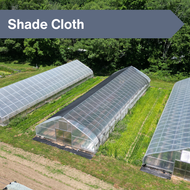Why Shade Cloth Matters More Than You Think
May 8th 2025

Why Shade Cloth Deserves a Place in Your Greenhouse Plan
Ask any seasoned grower and they’ll tell you: temperature control inside a greenhouse isn’t just a summer battle—it’s a season-long strategy. And while fancy fans, vents, and automation get a lot of attention, one of the simplest and most powerful tools often gets overlooked: shade cloth.
At CT Greenhouse, we’ve walked enough rows and watched enough seasons turn to know one thing: sometimes the low-tech solutions make the biggest difference. Shade cloth is one of them.
In this post, we’ll dig into what shade cloth actually does, when and how to use it, and how a small investment can lead to stronger crops, longer harvests, and a healthier farm operation.

What Shade Cloth Really Does—And Why It Works
At its core, shade cloth is about light and heat management. It’s a physical barrier that knocks down solar radiation before it turns your house into an oven. But good shade cloth doesn’t just block sunlight—it modifies it.
Here’s how it helps:
- Reduces incoming heat load: keeping temperatures cooler without constant fan use
- Diffuses sunlight: spreading light more evenly across plants, reducing burn spots
- Lowers evaporation rates: helping soils and plants retain more moisture
- Creates a more stable microclimate: reducing daily temperature swings that stress plants
Unlike plastic covers or ventilation equipment, shade cloth acts passively—once installed, it works all day without needing power, switches, or management.
The Benefits of Shade Cloth: Crop and Farm Payoffs
- Cooler, More Consistent Temperatures
Shade cloth can lower interior temperatures by 10–20°F, depending on airflow and shading percentage. That margin can save entire successions of greens, prevent blossom drop in tomatoes and peppers, and make day-to-day work inside the house far safer for you and your crew. - Sunburn and Stress Prevention
Plants can suffer sunscald just like human skin. High-intensity, direct sunlight can cause leaf burns, fruit cracking, and stunted growth. Shade cloth diffuses that sunlight across the canopy, protecting plants during their most vulnerable stages. - Water and Labor Savings
By slowing evaporation, shaded environments reduce the number of irrigation cycles needed during peak summer. That means fewer hoses dragged, less wear on drip systems, and better water use efficiency—critical in both dry regions and humid climates alike. - Longer Growing Windows
By moderating heat inside the structure, you can start earlier in spring and extend harvests later into fall—giving you a stronger market position when competitors are struggling to produce. - Stronger Flower and Fruit Set
In crops like peppers, tomatoes, eggplant, and cucumbers, excessive daytime heat can cause flower abortion (blossom drop). Shade cloth helps maintain temperatures inside the critical reproductive window, preserving fruit set and overall yields.
Choosing the Right Shade Cloth for Your Farm
Not all shade cloth is created equal—and selecting the right one matters.
Shade Percentages (How Much Light You Block):
- 30–40%: Best for warm-weather crops like tomatoes, melons, peppers.
- 50–60%: Great for mixed-crop houses or areas with moderate summer heat.
- 60–70%: Ideal for leafy greens, flowers, and farms in extreme heat regions.
Material Types:
- Woven Shade Cloth: Heavy-duty, built for long-term or permanent installation. Often finished with brass grommets and hemmed edges.
- Knitted Shade Cloth: Lightweight, flexible, easier to handle seasonally. Higher tear resistance and more UV stable over time.
Color Options:
- Black (most common): Durable, affordable, and versatile.
- White or Reflective (specialty uses): Best for minimizing heat buildup while allowing high diffused light, useful in very hot climates or flower production.
*** CT Greenhouse Tip:For tunnels where you want a seasonal install/removal, go knitted. For houses that face brutal summers year after year, woven cloth with hemmed edges is worth the extra cost.
Installing Shade Cloth: Simple and Flexible Options
You don’t need major retrofits or specialty crews to add shade cloth to your greenhouse. Most installs can be done in a few hours with basic hand tools.
Common Install Methods:
- Attach over the top of your house using existing wirelock and wiggle wire systems
- Tie off directly to eye bolts or purlins with UV-resistant rope
- Drape inside for targeted protection over sensitive beds
- Roll up and secure it seasonally, or leave it installed for year-round moderation
Good to Know:
Shade cloth installation is completely reversible. If you want full sun exposure for overwintering crops or early spring germination, just roll it up or remove it without impacting your tunnel frame or plastic cover.
Field Lessons: When and Where to Use Shade Cloth
We’ve seen shade cloth make a critical difference in:
- Early-season lettuce and spinach survival during May heat waves
- Mid-summer pepper and tomato flower retention
- Cool-season transplant hardening off without leaf burn
- Flower production houses looking for slower bolt and longer color shelf life
It’s one of the few upgrades that helps across all production styles—row crops, raised beds, hydroponic houses, and propagation tunnels alike.
Small Investment, Big Impact
Shade cloth isn’t just a summer tool. It’s a strategic investment in your farm’s year-round success. A single extra harvest of greens, a few saved beds of summer squash, or a stronger tomato set can more than pay for the cost of installation.
And more than the economics, it creates a growing environment that’s better for your crops, your soil, your team—and yourself.
Thinking About Adding Shade Cloth This Season?
At CT Greenhouse, we’re here to help—not upsell.
Whether you want to throw shade across your whole house, just over one sensitive bed, or figure out the right material and percentage for your zone, we’ll walk you through the options.
No pressure. No gimmicks. Just answers that match your farm’s needs.
PRINT SHADE CLOTH RESOURCE GUIDE
Let’s grow smarter, together.
860-341-8707 | info@ctgreenhouse.com

